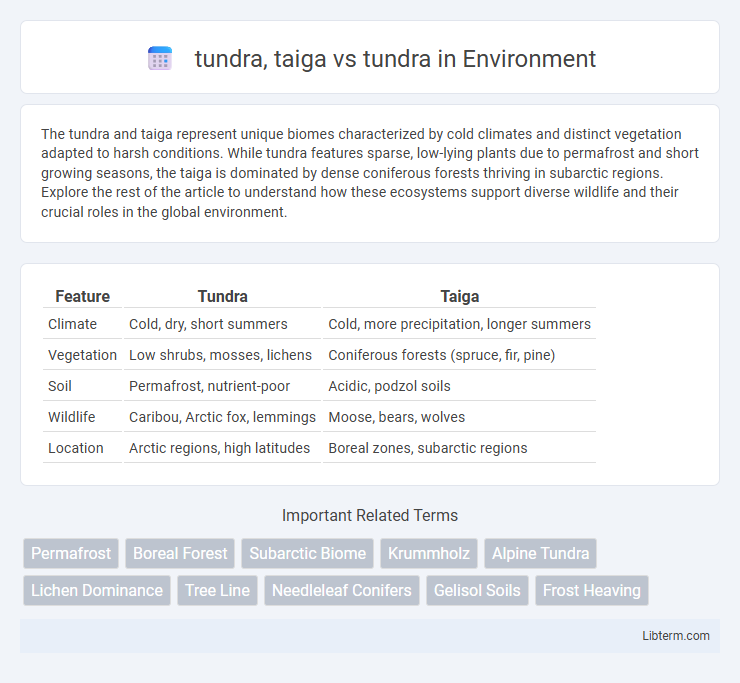The tundra and taiga represent unique biomes characterized by cold climates and distinct vegetation adapted to harsh conditions. While tundra features sparse, low-lying plants due to permafrost and short growing seasons, the taiga is dominated by dense coniferous forests thriving in subarctic regions. Explore the rest of the article to understand how these ecosystems support diverse wildlife and their crucial roles in the global environment.
Table of Comparison
| Feature | Tundra | Taiga |
|---|---|---|
| Climate | Cold, dry, short summers | Cold, more precipitation, longer summers |
| Vegetation | Low shrubs, mosses, lichens | Coniferous forests (spruce, fir, pine) |
| Soil | Permafrost, nutrient-poor | Acidic, podzol soils |
| Wildlife | Caribou, Arctic fox, lemmings | Moose, bears, wolves |
| Location | Arctic regions, high latitudes | Boreal zones, subarctic regions |
Introduction to Tundra and Taiga Biomes
Tundra and taiga are distinct biomes characterized by unique climatic and ecological features. The tundra biome experiences extremely cold temperatures, permafrost soil, and minimal vegetation primarily consisting of mosses, lichens, and low shrubs, while the taiga biome, also known as the boreal forest, is dominated by coniferous trees like spruce, fir, and pine, with cold winters and relatively warm summers. These biomes play critical roles in global carbon storage, biodiversity, and climate regulation due to their vast geographic distribution across high-latitude regions.
Defining Characteristics of the Tundra
The tundra is defined by its cold, arid climate with permafrost, minimal vegetation, and short growing seasons, contrasting with the taiga's dense coniferous forests and more moderate temperatures. Tundra landscapes have low biodiversity, dominated by mosses, lichens, and small shrubs, whereas taiga supports larger tree species such as spruce, pine, and fir. The tundra's soil remains frozen year-round, limiting root development and contributing to its sparse plant life, while taiga soils thaw seasonally, enabling deeper root systems and more complex ecosystems.
Key Features of the Taiga Biome
The Taiga biome, also known as boreal forest, is characterized by dense coniferous forests dominated by species such as spruce, fir, and pine, thriving in cold climates with slightly more precipitation compared to the tundra. Unlike the tundra's treeless landscape and permafrost soils, the Taiga supports a rich diversity of wildlife including moose, bears, and lynx, adapted to long, harsh winters and short, moist summers. This biome plays a crucial role in carbon sequestration due to its extensive forest cover and thicker soil layers, contrasting with the tundra's limited vegetation and nutrient-poor soils.
Climate Differences: Tundra vs Taiga
The informal sector often lacks legal protections, social security, and minimum wage guarantees, exposing workers to exploitation and poor working conditions. In contrast, the formal sector provides regulated employment with enforced labor laws, social benefits, and access to healthcare and pensions, promoting worker stability and well-being. The disparity significantly impacts social equity, as informal workers face higher vulnerability without formal rights or institutional support.
Vegetation and Plant Adaptations
Tundra vegetation is dominated by low-growing plants such as mosses, lichens, and grasses adapted to cold, nutrient-poor soils with short growing seasons, featuring shallow root systems and antifreeze proteins to withstand freezing temperatures. In contrast, taiga (boreal forest) primarily consists of evergreen conifers like spruce, fir, and pine trees with needle-like leaves coated in wax to reduce water loss and a thick bark to protect against cold. Plant adaptations in taiga include deeper root systems and seasonal needle shedding, enabling survival in acidic, well-drained soils and longer subzero periods compared to tundra.
Wildlife Diversity in Tundra and Taiga
Wildlife diversity in the taiga is greater than in the tundra, with the taiga hosting a wide range of mammals such as moose, lynx, and bears, along with numerous bird species adapted to coniferous forests. The tundra, characterized by its harsh, cold climate and permafrost, supports fewer species, primarily hardy animals like caribou, arctic foxes, and migratory birds during the brief summer. The taiga's dense forests provide varied habitats, while the tundra's open, treeless landscape limits biodiversity but supports uniquely adapted species.
Soil Composition and Nutrient Cycles
Tundra soil is characterized by permafrost with limited organic material and slow nutrient cycling, resulting in low fertility and sparse vegetation. Taiga soil, often podzol, has better drainage and richer organic layers due to needle litter from coniferous trees, supporting more active nutrient cycles. The faster decomposition rates in taiga enhance nutrient availability compared to the tundra's frozen, nutrient-poor soil.
Geographical Distribution and Locations
The tundra biome predominantly spans the Arctic regions of North America, Europe, and Asia, characterized by treeless plains and permafrost. In contrast, the taiga, or boreal forest, covers vast areas just south of the tundra across Canada, Russia, and Scandinavia, featuring dense coniferous forests. Both biomes represent northern latitudes but differ significantly in vegetation and climatic conditions due to their distinct geographical locations.
Environmental Challenges and Threats
Tundra ecosystems face severe environmental challenges such as permafrost thaw, leading to habitat loss and increased greenhouse gas emissions, while taiga forests experience threats from logging, wildfires, and pest outbreaks exacerbated by climate change. Both biomes suffer from rising temperatures disrupting native species and altering carbon storage dynamics. The tundra's fragile soil and low biodiversity make recovery slower compared to the more resilient yet vast taiga biome.
Conservation and Future Outlook
Tundra and taiga ecosystems face escalating threats from climate change, with tundra experiencing permafrost thaw and vegetation shifts, while taiga faces increased wildfires and pest outbreaks. Conservation efforts prioritize protecting biodiversity hotspots, promoting sustainable land use, and monitoring climate impacts through satellite data and ecological studies. Future outlooks emphasize enhancing global climate policies and investing in restoration projects to preserve carbon sinks critical for mitigating global warming.
tundra, taiga Infographic

 libterm.com
libterm.com